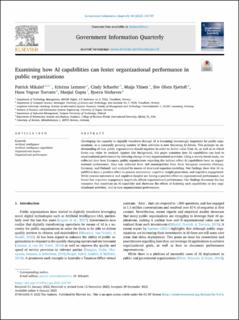| dc.contributor.author | Mikalef, Patrik | |
| dc.contributor.author | Lemmer, Kristina | |
| dc.contributor.author | Schaefer, Cindy | |
| dc.contributor.author | Ylinen, Maija | |
| dc.contributor.author | Fjørtoft, Siw Olsen | |
| dc.contributor.author | Torvatn, Hans Yngvar | |
| dc.contributor.author | Gupta, Manjul | |
| dc.contributor.author | Niehaves, Bjoern | |
| dc.date.accessioned | 2023-12-20T11:59:04Z | |
| dc.date.available | 2023-12-20T11:59:04Z | |
| dc.date.created | 2023-01-18T14:03:59Z | |
| dc.date.issued | 2023 | |
| dc.identifier.citation | Government Information Quarterly: an international journal of information technology management, policies, and practices. 2023, 40 (2), . | en_US |
| dc.identifier.issn | 0740-624X | |
| dc.identifier.uri | https://hdl.handle.net/11250/3108381 | |
| dc.description.abstract | Developing the capacity to digitally transform through AI is becoming increasingly important for public organizations, as a constantly growing number of their activities is now becoming AI-driven. This prompts an understanding of how public organizations should organize in order to derive value from AI, as well as in which forms can value be realized. Against this background, this paper examines how AI capabilities can lead to organizational performance by inducing change in key organizational activities. Using a survey-based study, we collected data from European public organizations regarding the indirect effect AI capabilities have on organizational performance. Data was collected from 168 municipalities from three European countries (Norway, Germany, and Finland) and analyzed by means of structural equation modeling. Our findings show that AI capabilities have a positive effect on process automation, cognitive insight generation, and cognitive engagement. While process automation and cognitive insights are having a positive effect on organizational performance, we found that cognitive engagement negatively affects organizational performance. Our findings document the key resources that constitute an AI capability and showcase the effects of fostering such capabilities on key organizational activities, and in turn organizational performance. | en_US |
| dc.language.iso | eng | en_US |
| dc.publisher | Elsevier | en_US |
| dc.rights | Navngivelse 4.0 Internasjonal | * |
| dc.rights.uri | http://creativecommons.org/licenses/by/4.0/deed.no | * |
| dc.title | Examining how AI capabilities can foster organizational performance in public organizations | en_US |
| dc.title.alternative | Examining how AI capabilities can foster organizational performance in public organizations | en_US |
| dc.type | Peer reviewed | en_US |
| dc.type | Journal article | en_US |
| dc.description.version | publishedVersion | en_US |
| dc.source.pagenumber | 14 | en_US |
| dc.source.volume | 40 | en_US |
| dc.source.journal | Government Information Quarterly: an international journal of information technology management, policies, and practices | en_US |
| dc.source.issue | 2 | en_US |
| dc.identifier.doi | 10.1016/j.giq.2022.101797 | |
| dc.identifier.cristin | 2109487 | |
| cristin.ispublished | true | |
| cristin.fulltext | preprint | |
| cristin.qualitycode | 2 | |

